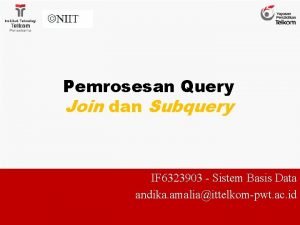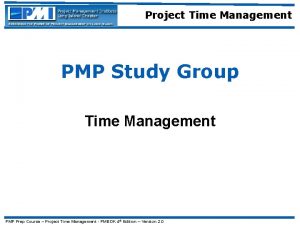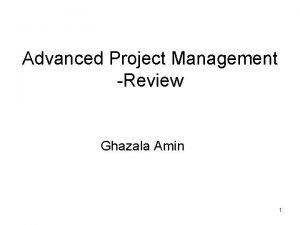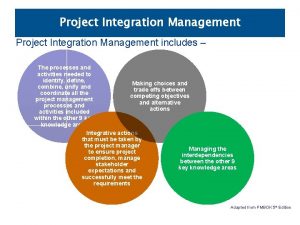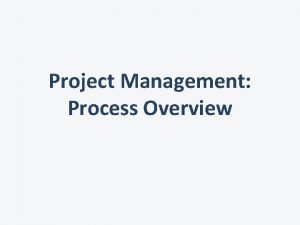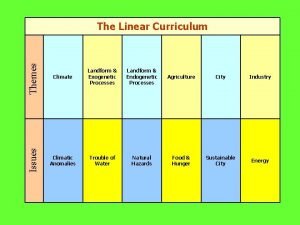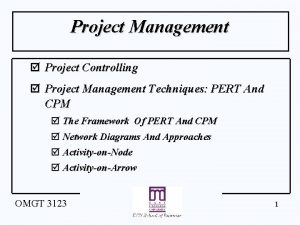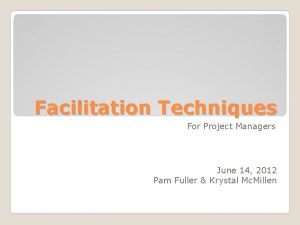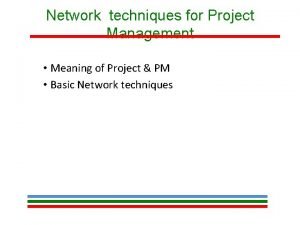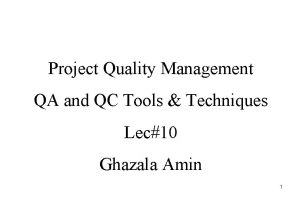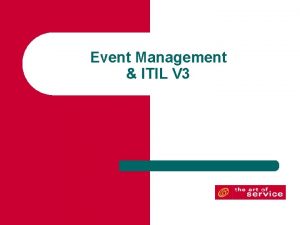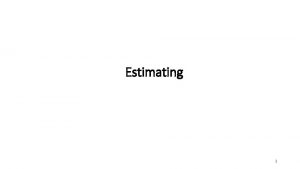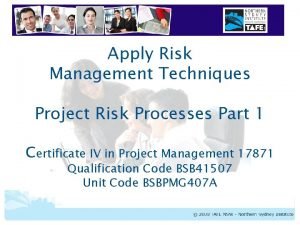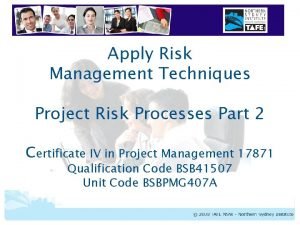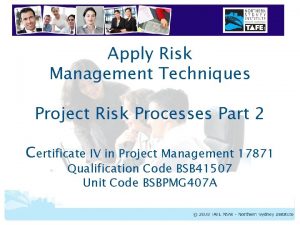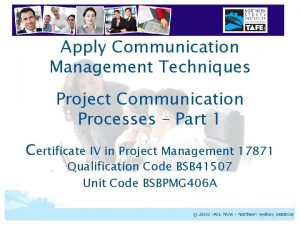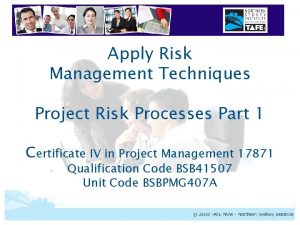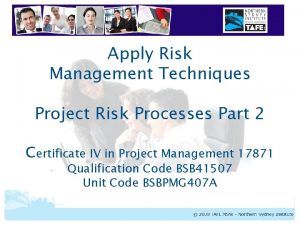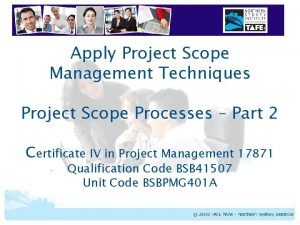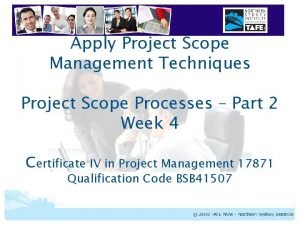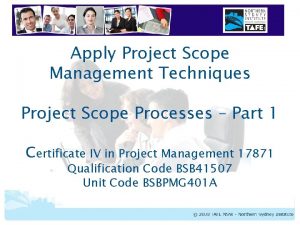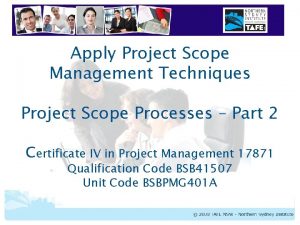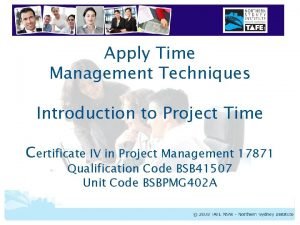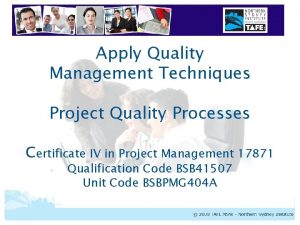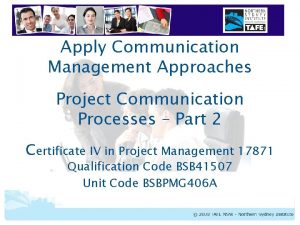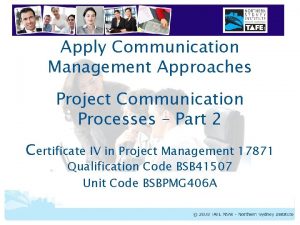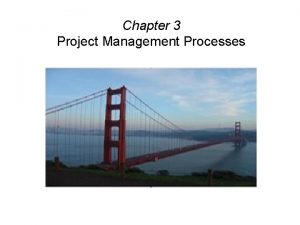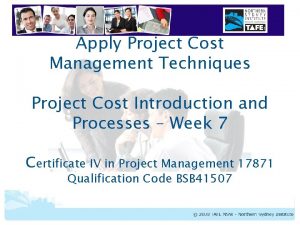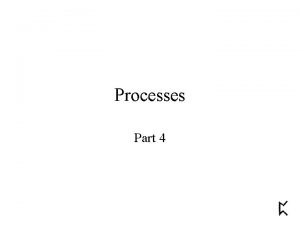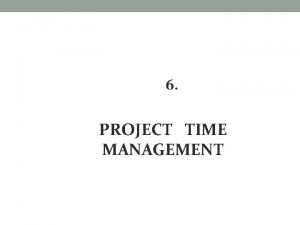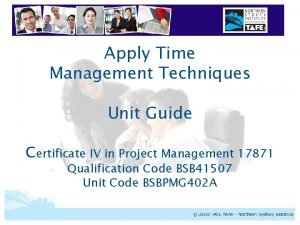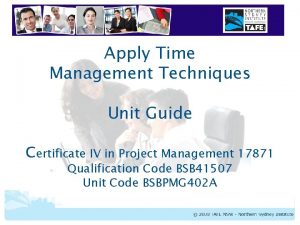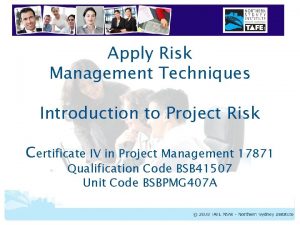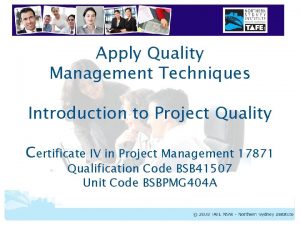Apply Time Management Techniques Project Time Processes Part


























- Slides: 26

Apply Time Management Techniques Project Time Processes – Part 1 Certificate IV in Project Management 17871 Qualification Code BSB 41507 Unit Code BSBPMG 402 A Apply Time Management Techniques

Project Time Management Processes PMBOK Project Time Management Processes 6. 1 Define Activities 6. 2 Sequence Activities 6. 3 Estimate Activity Resources 6. 4 Estimate Activity Duration 6. 5 Develop Schedule 6. 6 Control Schedule Related processes from Project Integration Management – PMBOK 4 th Edition BSBPMG 402 A Apply Time Management Techniques

Project Time Processes – Part 1 • PMBOK Project Time Management Processes • 6. 1 Define Activities • 6. 2 Sequence Activities • 6. 3 Estimate Activity Resources • 6. 4 Estimate Activity Duration • 6. 5 Develop Schedule • 6. 6 Control Schedule • Related processes from Project Integration Management – BSBPMG 402 A Apply Time Management Techniques • 4. 1 Develop Project Charter

Learning Objectives – Part 1 1. Understand of the processes required to manage Project Time 2. Acquire the skills and knowledge required to assist with project scheduling activities 3. Explain the project scheduling process and several tools and techniques used to define and sequence activities 4. Understand the different types of logical relationships and dependencies between BSBPMG 402 A Apply Time Management Techniques

Reading – Time Processes Part 1 Please take some time to review the PMBOK Chapters 4. 1, 4. 2, 6. 1, 6. 2 This could take 30 to 45 minutes BSBPMG 402 A Apply Time Management Techniques

4. 1 Develop Project Charter • The process of developing a document that formally defines and authorises a project by documenting the initial requirements that will satisfy the needs of the Project Sponsor and stakeholder • The high level Project Timeframe is often specified during this process • Any Project Timeframes specified at this stage are predictions or preferences only, they have been subject to detailed planning and scheduling processes Monitor Initiation Planning Execution Close Control Adapted from PMBOK 4 th Edition BSBPMG 402 A Apply Time Management Techniques

4. 1 Develop Project Charter • Inputs into the Project Charter that have a major impact on Project Timeframe • Business need or rationale • Strategic Plan • Business Case assumptions • Contractual requirements • Methodologies, policies and procedures • The output at this stage is a preferred Project Timeframe • It is best specified as a range estimate eg 6 BSBPMG 402 A Apply Time Management Techniques months +/- 4 weeks

4. 2 Develop Project Management Plan • This is the process of defining and documenting the actions necessary to prepare and integrate all subsidiary plans for each of the 8 key knowledge areas of project management. • Good practice dictates that the Project Management Plan is baselined at the end of the Planning Phase, particularly in the areas of scope, cost and time Monitor Initiation Planning Execution Close Control Adapted from PMBOK 4 th Edition • It is progressively updated during project BSBPMG 402 A Apply Time Management Techniques

4. 2 Develop Project Management Plan • The planning processes for all project management key knowledge areas are normally performed at the same time and during this process, or expanded upon shortly afterwards • The relationship to Scope, Time and Cost is slightly different to the other areas of Communication, Risk, Human Resources, Quality and Procurement • There are no stand alone Scope, Time or Cost Planning processes, they contained Adapted from PMBOK 4 th Edition BSBPMG 402 A Apply Time Management Techniques

Schedule Management Plan • The Schedule Management Plan is a critical output of this process and is critically connected to all the Project Time Management processes that occur within the Planning phases – (6. 1 to 6. 5) • Often called the Time Management Plan and very often overlooked entirely, which is unfortunate as it is a critical management tool for the Project Schedule • Common inclusions in the Schedule Management Plan – • Schedule baseline • Processes, tools and techniques used to estimate activity duration • Processes to Monitor and Control time • Change Control process • Assumptions, dependencies and constraints Monitor Initiation Planning Execution Close Control Adapted from PMBOK 4 th Edition BSBPMG 402 A Apply Time Management Techniques

6. 1 Define Activities • The process of identifying the specific activities to be performed to produce the project deliverables • All activities should relate to a project deliverable • Takes the deliverables and work packages defined in the WBS and decomposes them into activities Monitor Initiation Planning Execution Close • Activities provide the basis for estimating, scheduling, executing, and monitoring and Control Adapted from PMBOK 4 th Edition BSBPMG 402 A Apply Time Management Techniques

6. 1 Define Activities • Inputs to Define Activities • Scope Baseline • Project Management methodologies and procedures • Standard project schedules and activities • Historical data on similar projects Expert Judgement Decomposition Rolling Wave • Tools and techniques to Define Activities Planning Templates Adapted from PMBOK 4 th Edition BSBPMG 402 A Apply Time Management Techniques

6. 1 Define Activities • Rolling Wave Planning – • Progressively elaborate on the project plan and schedule • Plan near term activities in detail and • Templates • Acceptance criteria • Support and training requirements • Assumptions and constraints Monitor Initiation Planning Execution Close Control Adapted from PMBOK 4 th Edition BSBPMG 402 A Apply Time Management Techniques

6. 1 Define Activities • Outputs of this process include – • Activity List – Includes scope of work description for each activity • Activity Attributes – Progressively fleshed out during time planning processes • Milestone List – Highlight significant points in project execution to focus attention on the project schedule Monitor Planning Execution Close – Can be related to contract obligations, Initiation external dependencies, completion of major deliverables. Control or phases Adapted from PMBOK 4 Edition th – Can be mandatory or for information purposes BSBPMG 402 A Apply Time Management Techniques

6. 2 Sequence Activities • The process of identifying and documenting relationships between the project activities • Every activity, except the first and last, must be connected to at least one predecessor and one successor • Milestones are generally connected to predecessor and successor activities with some exceptions, particularly when the milestone denotes an external dependency or a major event that is outside of the Monitor Initiation Planning Execution Close Control Adapted from PMBOK 4 th Edition BSBPMG 402 A Apply Time Management Techniques

6. 2 Sequence Activities • Inputs to Sequence Activities • Activity List and Attributes • Milestone List • Project Scope Statement • Work Breakdown Structure • Learning from past projects Lead & • Tools. Precedence and techniques to Sequence Lag Times Schedule Dependency Diagramming Activities Determination Templates (advanced technique) Adapted from PMBOK 4 th Edition BSBPMG 402 A Apply Time Management Techniques

Precedence Diagramming Method • This is one of the key techniques used to sequence activities in projects • It has become an industry standard and underpins project management software that produces both GANTT and PERT charts • Defines 4 types of logical relationships between activities Monitor Initiation 1. Finish-to-start (FS) 2. Finish-to-finish (FF) BSBPMG 402 A Apply Time Management Techniques 3. Start-to-start (SS) Planning Execution Close Control Adapted from PMBOK 4 th Edition

Finish-to-start Relationships • The initiation of the successor activity depends on the completion of the predecessor activity • Translated this means…you can't start the 2 nd activity until the 1 st one is finished • In a GANTT chart this is depicted as an arrow from the end of the first activity Activity 1 pointing to the start of the second activity Activity 2 • Most common type of logical relationship between activities Finish-to-start Adapted from PMBOK 4 th Edition BSBPMG 402 A Apply Time Management Techniques

Finish-to-finish Relationships • The completion of the successor activity depends on the completion of the predecessor activity • Translated this means…both activities must end at the same time • In a GANTT chart this is depicted as an Activity 1 arrow from the end of the first activity Activityof 2 the second activity pointing to the end and the end dates need to be the same Finish-to-finish Adapted from PMBOK 4 th Edition BSBPMG 402 A Apply Time Management Techniques

Start-to-start Relationships • The initiation of the successor activity depends on the initiation of the predecessor activity • Translated this means…both activities must start at the same time • In a GANTT chart this is depicted as an Activity 1 arrow from the start of the first activity Activity 2 pointing to the start of the second activity and the start dates need to be the same Start-to-start Adapted from PMBOK 4 th Edition BSBPMG 402 A Apply Time Management Techniques

Start-to-finish Relationships • The completion of the successor activity depends on the initiation of the predecessor activity • Translated this means…the second activity can’t finish until the first activity starts • Very RARE and not available in some 1 project management. Activity software Activity 2 • In a GANTT chart this is depicted as an arrow from the start of the first activity Start-to-finish Adapted from PMBOK 4 th Edition BSBPMG 402 A Apply Time Management Techniques

Example Relationships Finish-to-start This means that Activity B cannot start until Activity A has completed. This is by far the most common relationship between multiple activities. Activity A is “Create the Project Charter” Activity B is “Obtain Project Charter approval from the Project Sponsor” This finish-to-start relationship would say that we must create the Project Charter before we obtain Project Charter approval from the Project Sponsor Finish-to-finish This means Activity A must finish before Activity B can finish. Assume you’re cooking dinner and you want the turkey to finish cooking before the potatoes. Activity A is “Cook turkey” Activity B is “Cook potatoes” The finish-to-finish relationship says that the turkey must finish cooking (activity A) before the potatoes finish cooking (activity B). This relationship is based on the end times. They can each start whenever they need to, as long as they finish in this order. Start-to-start Start-to-finish This means Activity A must start before Activity B can start. Assume that you are having your walls painted in one room and wallpaper is being hung in another room. You want to minimize the total disruption by having both activities happen at the same time. Activity A is “Paint the walls” Activity B is “Hang the wallpaper” Let’s assume that you want to fertilize your garden, but the plants must all be wet when the fertilizer is applied. Activity A is to “fertilize the garden. ” Activity B is to “water the garden” The wallpaper hangers may be ready to go (activity B). However, the start-to-start relationship says that they cannot start until the painting starts (activity A). This relationship is based on the activity start times. The end times of each activity are not related and, in fact, one activity could end at a much later time than the other. BSBPMG 402 A Apply Time Management Techniques The start-to-finish relationship says we need to start watering the garden (activity B) first to get the plants wet. This activity must continue until the fertilizing starts (activity A). This will ensure the plants remain wet until the fertilizer is ready to be applied. Note that you can start watering at any time and you can finish fertilizing at any time. The relationship only ties the start of activity A to the completion of activity B.

Types of Dependencies • Mandatory • Contractually required or inherent in the nature of the work • Often involve physical limitations • Discretionary • Based on preferences and knowledge of best practice • Can be reviewed if fast tracking of project schedules is required Monitor • External Initiation Planning Execution Close Control from PMBOK 4 Edition • A relationship between project activities. Adapted and BSBPMG 402 A Apply Time Managementoutside Techniques of the project and outside of the activities th

6. 2 Sequence Activities • Outputs of this process include – • Draft Project Schedule – Most Common – High level project schedule with phases, deliverables, activities and interdependencies • Project Network Diagrams – High level PERT chart excluding time estimates, shows interdependencies between all activities • Project Document Updates – Changes to Activity Lists and Attributes. Initiation – Changes to the Risk Register – Changes to the Work Breakdown Structure BSBPMG 402 A Apply Time Management Techniques Monitor Planning Execution Close Control Adapted from PMBOK 4 th Edition – Changes to Project Scope via Change Requests

Activity Relationships Forum 1. Take some time to reflect on the 4 different types of interrelationships that are possible between project activities. 2. Reflect on projects that you have been involved with and do some online research to find your best examples, one for each of the 4 relationship types (FF, SF, FS, SS) 3. Then go. Research to the Forum on Activity Practice Comment Relationships load up your examples and provide comments on the examples BSBPMG 402 A Apply Time Management Techniques

Next Steps Please proceed to Time Processes Part 2 in the Learning Program. Best of Luck! BSBPMG 402 A Apply Time Management Techniques
 Cross apply vs outer apply
Cross apply vs outer apply Time management pmp
Time management pmp Concurrent in os
Concurrent in os Project management processes
Project management processes Project integration management example
Project integration management example Six processes of project integration management
Six processes of project integration management A process consists of one or more
A process consists of one or more Importance of software project management
Importance of software project management Concasse cut size in mm
Concasse cut size in mm Exogenetic processes part 2
Exogenetic processes part 2 Risk mitigation techniques in project management
Risk mitigation techniques in project management Pert metoda
Pert metoda Facilitation techniques in project management
Facilitation techniques in project management Explain the network techniques for project management
Explain the network techniques for project management Quality control tools and techniques
Quality control tools and techniques The role of project management in achieving project success
The role of project management in achieving project success Modern process transitions in spm
Modern process transitions in spm How to reduce project duration
How to reduce project duration Introduction to project management kathy schwalbe
Introduction to project management kathy schwalbe Project evaluation in software project management
Project evaluation in software project management Types of project audit in project management
Types of project audit in project management Ms project agile planning
Ms project agile planning Types of project termination in project management
Types of project termination in project management Fonctions techniques
Fonctions techniques Wharton risk management program
Wharton risk management program Event management itil
Event management itil Pmbok cost management
Pmbok cost management
